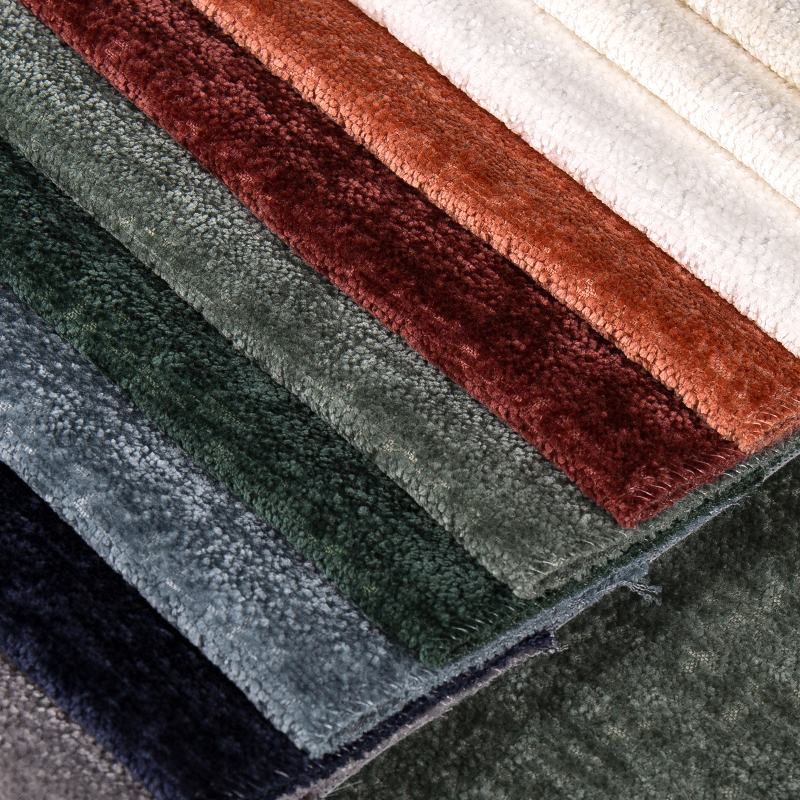Apr 24, 2025
Polyester chenille upholstery fabric is generally known for its durability and resilience, making it a popular choice for high-traffic environments and pet-friendly homes. However, its performance in the face of wear and tear from pets or high-traffic areas depends on several factors:
1. Durability and Resilience
Polyester chenille is a synthetic fabric that tends to be resistant to wear and tear compared to natural fibers. The fabric’s tight weave and strong fibers can withstand abrasion, making it suitable for areas with regular foot traffic. However, constant exposure to friction, like pets jumping on and off furniture, may cause the fabric to show signs of wear over time.
In high-traffic environments, the fabric’s pile density and the tightness of the weave play a crucial role in determining its ability to withstand wear. Polyester chenille with a higher pile density is generally more resistant to the effects of wear, as the fibers are packed more closely together.
2. Resistance to Pet Damage
Pet claws and scratching: Polyester chenille is relatively resistant to damage from pet claws, but it is not completely immune. The texture of chenille can make it more susceptible to snags and pulls from pet claws, especially if the fabric is loosely woven. Over time, scratching by pets can damage the fibers, leading to fraying or even holes in areas of high activity.
Pet hair: Polyester chenille fabric tends to attract pet hair, particularly due to its soft and plush texture. While pet hair is generally easier to remove from polyester than from some other fabrics (like velvet), regular maintenance is necessary to prevent it from embedding deep into the fabric. Vacuuming and using pet hair removers can help mitigate this issue.
3. Stain Resistance
Polyester chenille fabrics are often treated with stain-resistant finishes, which makes them more capable of handling spills or accidents from pets. However, frequent exposure to dirt, oils, and pet stains can build up over time. While the fabric is generally easy to clean, it requires consistent care to maintain its appearance, especially in high-traffic areas where stains are more likely to occur.
4. Pilling
Pilling is a common concern with chenille fabrics, especially with frequent usage. When polyester chenille is subjected to constant friction, the loose fibers in the weave may form small balls (pills) on the surface of the fabric. In high-traffic areas or homes with pets, the likelihood of pilling increases due to the repetitive movements of people and pets on the sofa.
While pilling is not a sign of poor quality, it can affect the appearance of the fabric over time. Regular use of a fabric shaver can help remove pills and maintain the fabric's appearance.

5. Abrasion Resistance
Polyester chenille's resistance to abrasion is generally good, making it a durable option for furniture subjected to constant use. However, in high-traffic environments, repeated friction may cause the fibers to break down and weaken, leading to a reduction in overall lifespan.
To prolong the fabric's life in high-traffic areas, it's important to rotate cushions regularly and consider adding slipcovers or protective furniture pads to areas that see the most use.
6. Color Retention
Polyester chenille fabric holds color well, even with exposure to pets, sunlight, and frequent cleaning. However, if the fabric is subject to heavy wear and tear, such as constant pet activity or daily foot traffic, the color may begin to fade gradually over time. The fabric’s ability to maintain its vibrant color depends on the quality of the dye and the regularity of cleaning.
7. Maintenance Tips for High-traffic & Pet-friendly Areas
Regular cleaning: Vacuum the fabric frequently to remove dust, dirt, and pet hair. A lint roller or pet hair remover can be used for easy hair removal.
Protective treatments: Consider applying a fabric protector or stain-resistant treatment to help prevent damage from pet accidents or spills.
Pet-friendly furniture covers: Using removable and washable slipcovers or throws can help protect the upholstery from damage caused by pets or high-traffic use.
Rotating cushions: Rotating cushions periodically helps distribute wear evenly, preventing one area from experiencing excessive wear.